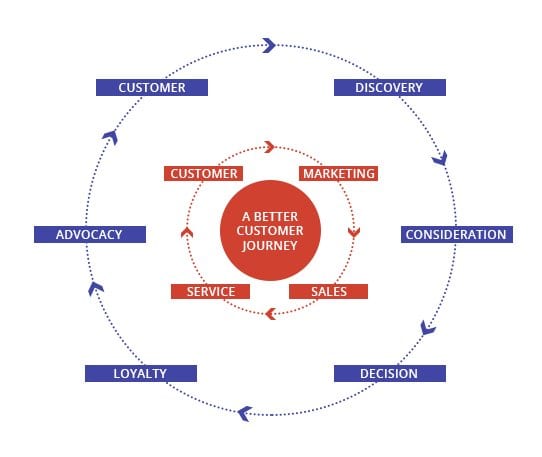
Once upon a time, price and quality were the essence of buying decisions, but today more and more people are choosing brands based on whether the overall customer experience meets their expectations, and the failure to do is leading customers to look for brands that will. As the Millennial generation has become the largest worldwide, it’s now crucial that a brand’s customer service capabilities are ready to meet the needs of these customers and to provide the experience they expect.
In fact, a recent study reveals that 72% of Millennials are actually more likely to spend their hard-earned money on positive experiences rather than on strictly material products. So how can customer service agents go about providing the customer experience this generation is looking for? It all starts with first understanding the context and background of the customers’ service journey.

Understanding the Customer Journey
The customer journey is essentially the relationship between the customer and the brand. It begins with the very first impression that a customer forms of the brand, and encompasses all the experiences and interactions at every touch point across the entire customer lifecycle, including all of their needs, preferences, and pain points that emerge along the way. For customer service agents, having knowledge and understanding of this journey is crucial to providing the best customer experience, and as a result, gaining their loyalty and advocacy. This understanding begins, first of all, with the awareness that the customer journey started before they made that call. Unfortunately, too often contact centers assume that the journey starts the moment an agent answers the phone, and therefore even though they might be checking all the boxes in the call flow procedure, that doesn’t mean the customer necessarily had a good experience, for what an agent may see as exemplary customer service often isn’t what the customer sees. In fact, the results of one recent survey found that while 80% of companies think they offer exemplary customer service, only 8% of customers agreed! The truth is, in many cases, the call is actually the second or third step a customer has taken on their journey, which means the interaction already begins at a negative starting point, and the service agent must act accordingly.
Mapping Each Customer’s Journey
To this end, mapping the customer journey in the contact center is one of the most effective ways to understand every consumer experience built across different touch points. Customer journey maps are like roadmaps that detail the total sum of experiences that customers undertake as they interact with a brand, starting from shopping to buying and beyond. Mapping customer journeys help a company to see itself from an outside-in perspective, in its entirety, providing insight into the operations and the services they deliver. If brands want to create a differentiated, effortless experience for the customer, it’s vital that they understand the customer’s journey, and that they understand it from their perspective.
Today, with the trend toward big data analytics, brands now have that capability, and it is changing the way they communicate with their customers. By comparing and analyzing data from various sources, companies can get practical insights into each customer’s preferences and behavior, as well as identify customer pain and passion points more effectively, while even anticipating what customers will ask for in advance to quickly resolve each customer interaction. Of course, this approach can also extend to proactively contacting customers, such as sending relevant promotions, follow-up calls to ensure satisfaction, etc. which can significantly help companies not only meet, but exceed customer experience expectations, and keeping them happy customers.
Driving Process Improvement
Finally, equipped with individual customer maps, companies can better understand in the macro how call flow and client processes impact the customer experience, and gain key insights into what needs to change in order to streamline how agents serve their customers. How many channels must a customer interact with, or how often is a customer being transferred before their issue is resolved? What are the customer’s needs and how often do they align with standard agent procedure? Customer journey mapping provides the answers to these types of questions that drive process improvement. This is also where the human element is still critical, even in our digital age where technology could feasibly automate much of the contact center. It’s because data without human analysis is still only data. The resulting blueprint should provide highly actionable insight, leading management to simplify call flows and optimize processes, and providing a more efficient, personalized experience for every customer.
By mapping the customer journey, brands ensure customer-centricity in every element of the contact center, from customer interactions in real time to the management of call flow procedures. The result is a customer experience that can stand the test of time.
[About the author] Dylon Mills is the Director of Marketing Content Strategy & Development at Jacada. As such, Dylon’s main responsibilities are to strategize, create and deliver content for Jacada’s product portfolio that align with the global Go-To-Market strategy, corporate positioning, and marketing campaigns. Dylon’s prior work experience includes Product Management at one of the top Fortune 500 Technology companies, Symantec Corporation. Outside of work, Dylon enjoys problem-solving and any project that includes building/tinkering with tools. Dylon holds a BS Consumer Economics from the University of Georgia.
Dylon Mills is the Director of Marketing Content Strategy & Development at Jacada. As such, Dylon’s main responsibilities are to strategize, create and deliver content for Jacada’s product portfolio that align with the global Go-To-Market strategy, corporate positioning, and marketing campaigns. Dylon’s prior work experience includes Product Management at one of the top Fortune 500 Technology companies, Symantec Corporation. Outside of work, Dylon enjoys problem-solving and any project that includes building/tinkering with tools. Dylon holds a BS Consumer Economics from the University of Georgia.
)